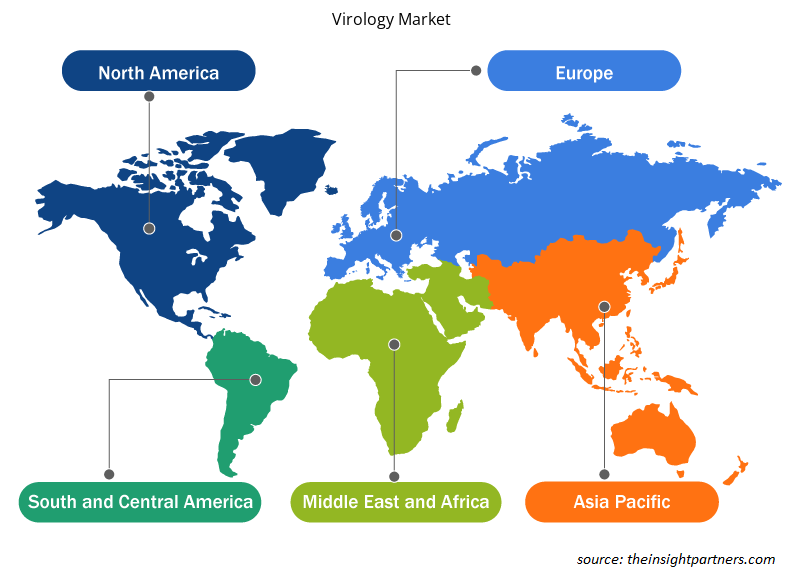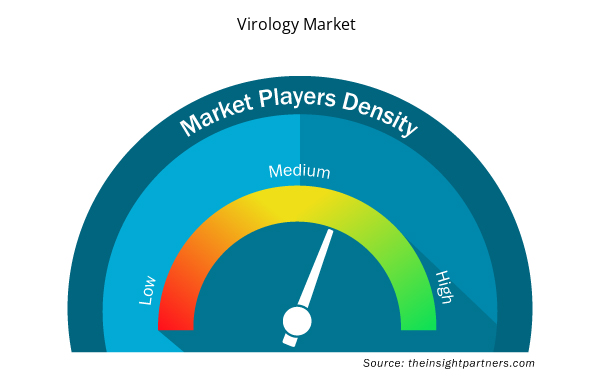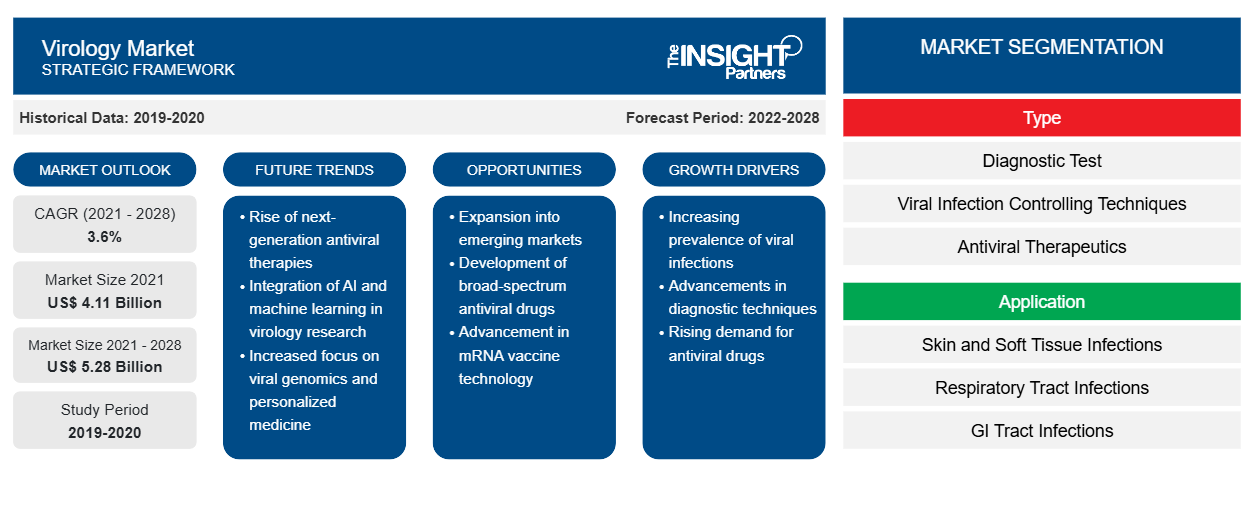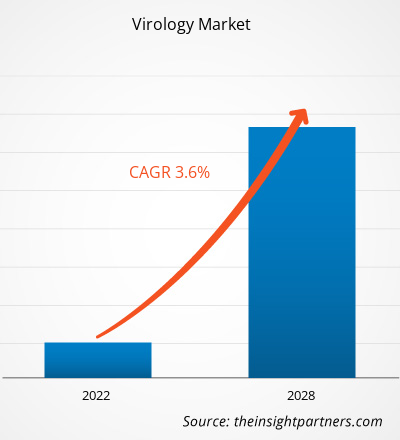Se proyecta que el mercado de virología alcance los US$ 5.276,48 millones para 2028 desde los US$ 4.108,27 millones en 2021; se espera que registre una CAGR del 3,6% entre 2021 y 2028.
La virología es una de las secciones más importantes del sistema de atención sanitaria. Tiene una amplia aplicación en el desarrollo de vacunas, diagnósticos, terapias de tratamiento y otros. Los actores del mercado de la virología participan constantemente en innovaciones y desarrollos de productos para mantener la competencia en el mercado. Exploran varios ámbitos para las innovaciones de productos. Por ejemplo, para COVID-19, los actores del mercado están invirtiendo significativamente en el desarrollo de vacunas, kits de prueba y otros productos y servicios relacionados. A continuación, se presentan algunos de los desarrollos del mercado relacionados con el mercado de la virología.
- En agosto de 2021, la Administración de Alimentos y Medicamentos de Estados Unidos (FDA) aprobó la primera vacuna contra la COVID-19, conocida como vacuna contra la COVID-19 de Pfizer-BioNTech . Se comercializará como ComiRNAty (Koe-mir'-na-tee). La vacuna está destinada a prevenir la enfermedad por COVID-19 en personas de 16 años o más. También está disponible bajo autorización de uso de emergencia ( EUA ).
- En abril de 2021, CerTest Biotec lanzó su prueba de diagnóstico COVID-19 con marcado CE para el sistema BD MAX.
- En mayo de 2020, Bio-Rad recibió la aprobación de la FDA para la autorización de uso de emergencia para la prueba de anticuerpos totales COVID-19.
- En mayo de 2020, Aalto Bio Reagents lanzó las nuevas proteínas Spike S1-S2 del SARS-CoV-2 eucariotas recombinantes .
De esta manera, esta participación activa de los actores del mercado a través de innovaciones de productos y el apoyo de los gobiernos en diferentes países refuerza el crecimiento del mercado de la virología.
Personalice este informe según sus necesidades
Obtendrá personalización en cualquier informe, sin cargo, incluidas partes de este informe o análisis a nivel de país, paquete de datos de Excel, así como también grandes ofertas y descuentos para empresas emergentes y universidades.
- Obtenga las principales tendencias clave del mercado de este informe.Esta muestra GRATUITA incluirá análisis de datos, desde tendencias del mercado hasta estimaciones y pronósticos.
Perspectivas de mercadoLa creciente adopción de procedimientos estéticos mínimamente invasivos y no invasivos impulsa el crecimiento del mercado de la virología
Virus como el virus de inmunodeficiencia humana (VIH), el virus de la gripe, el virus del Zika , el virus del Ébola, el SARS-CoV-2 y el virus de la poliomielitis infectan a grandes poblaciones en todo el mundo. A medida que el virus muta y evoluciona continuamente, la resistencia a los medicamentos se convierte en un gran desafío en el manejo de las infecciones virales entre los seres humanos y los animales. Un virus se transmite a través de varios medios según su tipo. Por ejemplo, algunos virus causan enfermedades virales respiratorias, como la gripe, el resfriado común y la infección por el virus respiratorio sincitial , y se transmiten a través de gotitas generadas al toser o estornudar, mientras que algunas enfermedades virales gastrointestinales se transmiten a través del contacto directo con las heces de personas infectadas o a través de alimentos o agua contaminados. Según las estadísticas mundiales sobre el VIH y el sida de ONUSIDA , más de 37,7 millones de personas en todo el mundo se infectaron por el VIH en 2020.
El Comité Internacional de Taxonomía de Virus ( ICTV ) declaró al nuevo coronavirus que causó la COVID-19 como el coronavirus 2 del síndrome respiratorio agudo severo (SARS-CoV-2) en febrero de 2020. El virus ha sufrido mutaciones un par de veces desde su brote, lo que ha aumentado la gravedad de la pandemia de COVID-19. Por ejemplo, según los datos del rastreador de COVID-19 de los Centros para el Control y la Prevención de Enfermedades (CDC), en agosto de 2021, la tasa de casos de siete días por cada 100.000 es de 299,4, y se notifican más de 164.952 casos nuevos en los EE. UU . Además, según el Centro Europeo para la Prevención y el Control de Enfermedades, en agosto de 2021, el recuento total de casos de COVID-19 alcanzó aproximadamente 36.307.572 pacientes en el Espacio Económico Europeo ( EEE ). Por lo tanto, esta creciente prevalencia de infecciones virales está impulsando el crecimiento del mercado de la virología.
Perspectivas regionales del mercado de virología
Los analistas de Insight Partners explicaron en detalle las tendencias y los factores regionales que influyen en el mercado de virología durante el período de pronóstico. Esta sección también analiza los segmentos y la geografía del mercado de virología en América del Norte, Europa, Asia Pacífico, Oriente Medio y África, y América del Sur y Central.

- Obtenga datos regionales específicos para el mercado de virología
Alcance del informe de mercado de virología
| Atributo del informe | Detalles |
|---|---|
| Tamaño del mercado en 2021 | US$ 4.11 mil millones |
| Tamaño del mercado en 2028 | 5.280 millones de dólares estadounidenses |
| CAGR global (2021-2028) | 3,6% |
| Datos históricos | 2019-2020 |
| Período de pronóstico | 2022-2028 |
| Segmentos cubiertos | Por tipo
|
| Regiones y países cubiertos | América del norte
|
| Líderes del mercado y perfiles de empresas clave |
|
Densidad de actores del mercado: comprensión de su impacto en la dinámica empresarial
El mercado de virología está creciendo rápidamente, impulsado por la creciente demanda de los usuarios finales debido a factores como la evolución de las preferencias de los consumidores, los avances tecnológicos y una mayor conciencia de los beneficios del producto. A medida que aumenta la demanda, las empresas amplían sus ofertas, innovan para satisfacer las necesidades de los consumidores y aprovechan las tendencias emergentes, lo que impulsa aún más el crecimiento del mercado.
La densidad de actores del mercado se refiere a la distribución de las empresas o firmas que operan dentro de un mercado o industria en particular. Indica cuántos competidores (actores del mercado) están presentes en un espacio de mercado determinado en relación con su tamaño o valor total de mercado.
Las principales empresas que operan en el mercado de virología son:
- Abad
- Servicios Johnson y Johnson, Inc.
- F. HOFFMANN-LA ROCHE LTD.
- TERMOFISHER CIENTIFIC INC.
- QIAGEN
Descargo de responsabilidad : Las empresas enumeradas anteriormente no están clasificadas en ningún orden particular.

- Obtenga una descripción general de los principales actores clave del mercado de virología
Perspectivas basadas en tipos
Según el tipo, el mercado de virología se segmenta en pruebas de diagnóstico, técnicas de control de infecciones virales, terapias antivirales e interferones. En 2021, se espera que el segmento de pruebas de diagnóstico tenga la mayor participación del mercado, y se estima que el segmento de técnicas de control de infecciones virales registrará la CAGR más alta durante 2021-2028.
Perspectivas basadas en aplicaciones
Según la aplicación, el mercado se segmenta en infecciones de la piel y los tejidos blandos, infecciones del tracto respiratorio, infecciones del tracto gastrointestinal, enfermedades de transmisión sexual, infecciones del tracto urinario y otras. En 2021, se estima que el segmento de infecciones del tracto respiratorio tendrá la mayor participación del mercado y se espera que registre la CAGR más alta durante 2021-2028.
Las empresas que operan en el mercado de la virología enfatizan en adoptar la estrategia de innovación de productos para satisfacer las cambiantes demandas de los clientes en todo el mundo, lo que también les permite mantener su marca en el mercado global.
Segmentación del mercado de virología
Por tipo
- Prueba de diagnóstico
- Prueba del virus del ADN
- Prueba del virus ARN
- Otros
- Técnicas de control de infecciones virales
- Profilaxis activa
- Profilaxis pasiva
- Terapéutica antiviral
- Agentes virucidas
- Agentes antivirales
- Inmunomoduladores
- Interferones
Por aplicación
- Infecciones de la piel y de los tejidos blandos
- Infecciones del tracto respiratorio
- Infecciones del tracto gastrointestinal
- Enfermedades de transmisión sexual
- Infecciones del tracto urinario
- Otros
Por el usuario final
- Hospitales
- Laboratorios de diagnóstico
- Empresas farmacéuticas y biotecnológicas
- Institutos de investigación y académicos
Por geografía
- América del norte
- A NOSOTROS
- Canadá
- México
- Europa
- Francia
- Alemania
- Italia
- Reino Unido
- España
- Resto de Europa
- Asia Pacífico
- Porcelana
- India
- Corea del Sur
- Japón
- Australia
- Resto de APAC
- Oriente Medio y África
- Sudáfrica
- Arabia Saudita
- Emiratos Árabes Unidos
- Resto de MEA
- América del Sur y Central
- Brasil
- Argentina
- Resto de estafa
Perfiles de empresas
- Abad
- Servicios Johnson & Johnson, Inc.
- F. Hoffmann-LA Roche Ltd.
- Termo Fisher Scientific, Inc.
- Qiagen
- Ilumina, Inc.
- Siemens AG
- GlaxoSmithKline S.A.
- Ciencias Gilead, Inc.
- AbbVie, Inc.nombres de pyright dados en los respectivos sitios web.
- Análisis histórico (2 años), año base, pronóstico (7 años) con CAGR
- Análisis PEST y FODA
- Tamaño del mercado Valor/volumen: global, regional, nacional
- Industria y panorama competitivo
- Conjunto de datos de Excel



Report Coverage
Revenue forecast, Company Analysis, Industry landscape, Growth factors, and Trends

Segment Covered
This text is related
to segments covered.

Regional Scope
North America, Europe, Asia Pacific, Middle East & Africa, South & Central America

Country Scope
This text is related
to country scope.
Preguntas frecuentes
The global virology market based on based on type is segmented into diagnostic test, viral infection controlling techniques, antiviral therapeutics, and interferons. In 2021, Antiviral Therapeutics segment is estimated to account for the largest market share in the global virology market. the growth can be attributed to increasing prevalence of human immunodeficiency virus (HIV) and increasing research and development investment by private and public companies for antiviral drugs.
The factors that are driving and restraining factors that will affect virology market in the coming years. Factors such as rising prevalence of viral infectious diseases and increasing product launches, are driving the market growth. However, availability of alternative products and high cost of production of products are likely to hamper the growth of the market.
The virology market majorly consists of the players such as Abbott, Johnson & Johnson Services, Inc., F. Hoffmann-LA Roche Ltd., Thermo Fisher Scientific, Inc., Qiagen, Illumina, Inc., Siemens AG, GlaxoSmithKline Plc, Gilead Sciences, Inc., and AbbVie, Inc. are amongst others.
The global virology market is segmented into North America, Europe, Asia Pacific, Middle East & Africa, and South & Central America. North America dominates the global virology market due to factors such as technological advancement, increasing product launches, and increasing investment in healthcare and research. The transmission of infectious diseases globally has made diagnosis mandatory for travelers. Today, the diseases are spreading faster around the world, which is further bolstering the demand for diagnostic tools as they can help control the outbreak at an early stage. For instance, in September 2019, the FDA approved OraQuick Ebola Rapid Antigen Test, a new rapid diagnostic test for Ebola in the US.
Asia Pacific is expected to be the fastest growing region Asia Pacific is expected to expand at a high growth rate due to large patient population, increasing government support to provide better healthcare services, and increasing product launches by market players. For instance, in 2018, Cepheid initiated the HBDC Access Program1 for the diagnosis of HIV, viral hepatitis (HCV), and human papillomavirus (HPV)2 at a relatively lower price. The company is aiming to make tests that would be more accessible to lower-income countries.
Virology is a detailed study of viruses that focuses on the structure, classification, evolution, and genetics of viruses. The virology market caters to the prevention and development of treatments for several viral diseases. The increasing prevalence of emerging infectious diseases (EIDs)—chikungunya, Ebola, West Nile virus, severe acute respiratory syndrome (SARS), and Lyme disease is driving the growth of the virology market. The key driving factors for the market growth are, rising prevalence of viral infections and other infectious diseases along with growing awareness about diagnosis and treatment of the disease.
Trends and growth analysis reports related to Life Sciences : READ MORE..
The List of Companies - Virology Market
- Abbott
- Johnson And Johnson Services, Inc.
- F. HOFFMANN-LA ROCHE LTD.
- THERMO FISHER SCIENTIFIC INC.
- QIAGEN
- Illumina, Inc.
- Siemens AG
- Glaxosmithkline Plc
- Abbvie Inc.
- Gilead Sciences, Inc.
The Insight Partners performs research in 4 major stages: Data Collection & Secondary Research, Primary Research, Data Analysis and Data Triangulation & Final Review.
- Data Collection and Secondary Research:
As a market research and consulting firm operating from a decade, we have published and advised several client across the globe. First step for any study will start with an assessment of currently available data and insights from existing reports. Further, historical and current market information is collected from Investor Presentations, Annual Reports, SEC Filings, etc., and other information related to company’s performance and market positioning are gathered from Paid Databases (Factiva, Hoovers, and Reuters) and various other publications available in public domain.
Several associations trade associates, technical forums, institutes, societies and organization are accessed to gain technical as well as market related insights through their publications such as research papers, blogs and press releases related to the studies are referred to get cues about the market. Further, white papers, journals, magazines, and other news articles published in last 3 years are scrutinized and analyzed to understand the current market trends.
- Primary Research:
The primarily interview analysis comprise of data obtained from industry participants interview and answers to survey questions gathered by in-house primary team.
For primary research, interviews are conducted with industry experts/CEOs/Marketing Managers/VPs/Subject Matter Experts from both demand and supply side to get a 360-degree view of the market. The primary team conducts several interviews based on the complexity of the markets to understand the various market trends and dynamics which makes research more credible and precise.
A typical research interview fulfils the following functions:
- Provides first-hand information on the market size, market trends, growth trends, competitive landscape, and outlook
- Validates and strengthens in-house secondary research findings
- Develops the analysis team’s expertise and market understanding
Primary research involves email interactions and telephone interviews for each market, category, segment, and sub-segment across geographies. The participants who typically take part in such a process include, but are not limited to:
- Industry participants: VPs, business development managers, market intelligence managers and national sales managers
- Outside experts: Valuation experts, research analysts and key opinion leaders specializing in the electronics and semiconductor industry.
Below is the breakup of our primary respondents by company, designation, and region:

Once we receive the confirmation from primary research sources or primary respondents, we finalize the base year market estimation and forecast the data as per the macroeconomic and microeconomic factors assessed during data collection.
- Data Analysis:
Once data is validated through both secondary as well as primary respondents, we finalize the market estimations by hypothesis formulation and factor analysis at regional and country level.
- Macro-Economic Factor Analysis:
We analyse macroeconomic indicators such the gross domestic product (GDP), increase in the demand for goods and services across industries, technological advancement, regional economic growth, governmental policies, the influence of COVID-19, PEST analysis, and other aspects. This analysis aids in setting benchmarks for various nations/regions and approximating market splits. Additionally, the general trend of the aforementioned components aid in determining the market's development possibilities.
- Country Level Data:
Various factors that are especially aligned to the country are taken into account to determine the market size for a certain area and country, including the presence of vendors, such as headquarters and offices, the country's GDP, demand patterns, and industry growth. To comprehend the market dynamics for the nation, a number of growth variables, inhibitors, application areas, and current market trends are researched. The aforementioned elements aid in determining the country's overall market's growth potential.
- Company Profile:
The “Table of Contents” is formulated by listing and analyzing more than 25 - 30 companies operating in the market ecosystem across geographies. However, we profile only 10 companies as a standard practice in our syndicate reports. These 10 companies comprise leading, emerging, and regional players. Nonetheless, our analysis is not restricted to the 10 listed companies, we also analyze other companies present in the market to develop a holistic view and understand the prevailing trends. The “Company Profiles” section in the report covers key facts, business description, products & services, financial information, SWOT analysis, and key developments. The financial information presented is extracted from the annual reports and official documents of the publicly listed companies. Upon collecting the information for the sections of respective companies, we verify them via various primary sources and then compile the data in respective company profiles. The company level information helps us in deriving the base number as well as in forecasting the market size.
- Developing Base Number:
Aggregation of sales statistics (2020-2022) and macro-economic factor, and other secondary and primary research insights are utilized to arrive at base number and related market shares for 2022. The data gaps are identified in this step and relevant market data is analyzed, collected from paid primary interviews or databases. On finalizing the base year market size, forecasts are developed on the basis of macro-economic, industry and market growth factors and company level analysis.
- Data Triangulation and Final Review:
The market findings and base year market size calculations are validated from supply as well as demand side. Demand side validations are based on macro-economic factor analysis and benchmarks for respective regions and countries. In case of supply side validations, revenues of major companies are estimated (in case not available) based on industry benchmark, approximate number of employees, product portfolio, and primary interviews revenues are gathered. Further revenue from target product/service segment is assessed to avoid overshooting of market statistics. In case of heavy deviations between supply and demand side values, all thes steps are repeated to achieve synchronization.
We follow an iterative model, wherein we share our research findings with Subject Matter Experts (SME’s) and Key Opinion Leaders (KOLs) until consensus view of the market is not formulated – this model negates any drastic deviation in the opinions of experts. Only validated and universally acceptable research findings are quoted in our reports.
We have important check points that we use to validate our research findings – which we call – data triangulation, where we validate the information, we generate from secondary sources with primary interviews and then we re-validate with our internal data bases and Subject matter experts. This comprehensive model enables us to deliver high quality, reliable data in shortest possible time.


 Obtenga una muestra gratuita de este informe
Obtenga una muestra gratuita de este informe